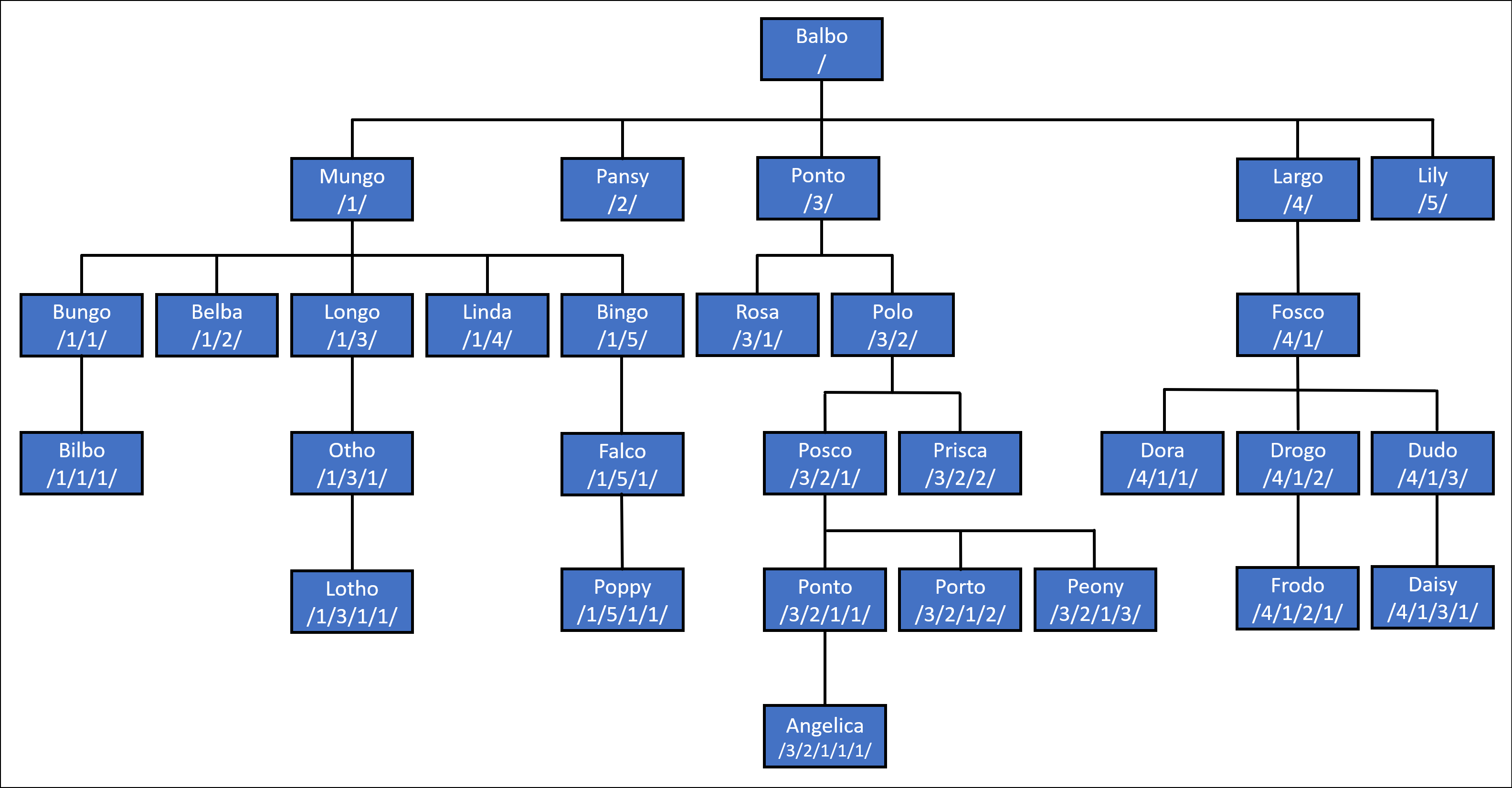Note
此功能是在 EF Core 8.0 加入。
Azure SQL 和 SQL Server 具有稱為 hierarchyid 的特殊資料類型,可用來儲存階層式資料。 在此例中,「階層式資料」本質上表示構成樹狀結構的資料,其中每個項目都可能有父系和/或子系。 這類資料包括以下範例:
- 組織結構
- 檔案系統
- 專案中的一組工作
- 語言詞彙的分類表
- 網頁之間的連結圖形
資料庫因此可以使用階層式結構,針對此資料執行查詢。 舉例來說,查詢可以尋找特定項目的上階和相依項目,或尋找階層中特定深度的所有項目。
在 .NET 和 EF Core 使用 HierarchyId
在最低層級,Microsoft.SqlServer.Types NuGet 套件包含名為 SqlHierarchyId 的類型。 雖然此類型支援使用 hierarchyid 值,但以 LINQ 使用時會有點繁瑣。
下個層級推出了新的 Microsoft.EntityFrameworkCore.SqlServer.Abstractions 套件,其中包含用於實體類型的更高階 HierarchyId 類型。
Tip
此 HierarchyId 類型比 SqlHierarchyId 更符合 .NET 的規範,它會在 .NET Framework 類型裝載於 SQL Server 資料庫引擎後進行建模。
HierarchyId 是設計來與 EF Core 搭配使用的,但也可在 EF Core 外部的其他應用程式使用。
Microsoft.EntityFrameworkCore.SqlServer.Abstractions 套件不會參照任何其他套件,因此對已部署的應用程式大小和相依性的影響極小。
對查詢和更新等 EF Core 功能使用 HierarchyId,需要 Microsoft.EntityFrameworkCore.SqlServer.HierarchyId 套件。 此套件包含 Microsoft.EntityFrameworkCore.SqlServer.Abstractions 和 Microsoft.SqlServer.Types 這些可轉移的相依性,因此通常是唯一必需的套件。
dotnet add package Microsoft.EntityFrameworkCore.SqlServer.HierarchyId
安裝套件之後,您可以在應用程式呼叫 HierarchyId 的過程中呼叫 UseHierarchyId,藉此使用 UseSqlServer。 例如:
options.UseSqlServer(
connectionString,
x => x.UseHierarchyId());
建立階層模型
此 HierarchyId 類型可用於實體類型的屬性。 舉例來說,假設我們想要為虛構的半身人的父系族譜建模。 在 Halfling 的實體類型中,HierarchyId 屬性可用於找出族譜中的每個半身人。
public class Halfling
{
public Halfling(HierarchyId pathFromPatriarch, string name, int? yearOfBirth = null)
{
PathFromPatriarch = pathFromPatriarch;
Name = name;
YearOfBirth = yearOfBirth;
}
public int Id { get; private set; }
public HierarchyId PathFromPatriarch { get; set; }
public string Name { get; set; }
public int? YearOfBirth { get; set; }
}
Tip
此處所示和下列範例的程式碼來自 HierarchyIdSample.cs。
Tip
如有需要,HierarchyId 可當作索引鍵屬性類型來使用。
在此例中,族譜是以家族的元老為根。 每個半身人都可以使用 PathFromPatriarch 屬性,從族譜中的元老往下追蹤。 SQL Server 會針對這些路徑使用精簡的二進位格式,但在處理程式碼時,通常會解析成人類可讀的字串格式。 在這種表示方式中,每個層級的位置會以 / 字元分隔。 以下圖的族譜為例:

在此族譜中:
- Balbo 位於族譜的根部,以
/表示。 - Balbo 有五個孩子,以
/1/、/2/、/3/、/4/和/5/表示。 - Balbo 的長子 Mungo 也有五個孩子,以
/1/1/、/1/2/、/1/3/、/1/4/和/1/5/表示。 請注意,Mungo 的HierarchyId(/1/) 是他所有孩子的前置詞。 - 同樣地,Balbo 的第三子 Ponto 有兩個孩子,以
/3/1/和/3/2/表示。 Ponto 的孩子每個都會前置HierarchyId,表示為/3/。 - 族譜再往下都是如此...
下列程式碼會將此族譜插入使用 EF Core 的資料庫:
await AddRangeAsync(
new Halfling(HierarchyId.Parse("/"), "Balbo", 1167),
new Halfling(HierarchyId.Parse("/1/"), "Mungo", 1207),
new Halfling(HierarchyId.Parse("/2/"), "Pansy", 1212),
new Halfling(HierarchyId.Parse("/3/"), "Ponto", 1216),
new Halfling(HierarchyId.Parse("/4/"), "Largo", 1220),
new Halfling(HierarchyId.Parse("/5/"), "Lily", 1222),
new Halfling(HierarchyId.Parse("/1/1/"), "Bungo", 1246),
new Halfling(HierarchyId.Parse("/1/2/"), "Belba", 1256),
new Halfling(HierarchyId.Parse("/1/3/"), "Longo", 1260),
new Halfling(HierarchyId.Parse("/1/4/"), "Linda", 1262),
new Halfling(HierarchyId.Parse("/1/5/"), "Bingo", 1264),
new Halfling(HierarchyId.Parse("/3/1/"), "Rosa", 1256),
new Halfling(HierarchyId.Parse("/3/2/"), "Polo"),
new Halfling(HierarchyId.Parse("/4/1/"), "Fosco", 1264),
new Halfling(HierarchyId.Parse("/1/1/1/"), "Bilbo", 1290),
new Halfling(HierarchyId.Parse("/1/3/1/"), "Otho", 1310),
new Halfling(HierarchyId.Parse("/1/5/1/"), "Falco", 1303),
new Halfling(HierarchyId.Parse("/3/2/1/"), "Posco", 1302),
new Halfling(HierarchyId.Parse("/3/2/2/"), "Prisca", 1306),
new Halfling(HierarchyId.Parse("/4/1/1/"), "Dora", 1302),
new Halfling(HierarchyId.Parse("/4/1/2/"), "Drogo", 1308),
new Halfling(HierarchyId.Parse("/4/1/3/"), "Dudo", 1311),
new Halfling(HierarchyId.Parse("/1/3/1/1/"), "Lotho", 1310),
new Halfling(HierarchyId.Parse("/1/5/1/1/"), "Poppy", 1344),
new Halfling(HierarchyId.Parse("/3/2/1/1/"), "Ponto", 1346),
new Halfling(HierarchyId.Parse("/3/2/1/2/"), "Porto", 1348),
new Halfling(HierarchyId.Parse("/3/2/1/3/"), "Peony", 1350),
new Halfling(HierarchyId.Parse("/4/1/2/1/"), "Frodo", 1368),
new Halfling(HierarchyId.Parse("/4/1/3/1/"), "Daisy", 1350),
new Halfling(HierarchyId.Parse("/3/2/1/1/1/"), "Angelica", 1381));
await SaveChangesAsync();
Tip
如有需要,十進位值可用來在兩個現有節點之間建立新節點。 例如,/3/2.5/2/ 會位在 /3/2/2/ 和 /3/3/2/ 之間。
查詢階層
HierarchyId 會公開多個可用於 LINQ 查詢的方法。
| Method | Description |
|---|---|
GetAncestor(int n) |
取得階層式樹狀結構中較高層級的節點 n。 |
GetDescendant(HierarchyId? child1, HierarchyId? child2) |
取得大於 child1 且小於 child2 的下階節點值。 |
GetLevel() |
取得階層式樹狀結構中此節點的層級。 |
GetReparentedValue(HierarchyId? oldRoot, HierarchyId? newRoot) |
取得代表新節點位置的值,這個節點來自 newRoot 的路徑等於來自 oldRoot 的路徑,能有效將節點移至新位置。 |
IsDescendantOf(HierarchyId? parent) |
取得的值指出此節點是否為 parent 的下階。 |
此外,運算子 ==、!=、<、<=、> 和 >= 也可使用。
以下是在 LINQ 查詢使用這些方法的範例。
在樹狀結構的指定層級取得實體
下列查詢會使用 GetLevel 傳回族譜中指定層級的所有半身人:
var generation = await context.Halflings.Where(halfling => halfling.PathFromPatriarch.GetLevel() == level).ToListAsync();
它會轉譯為下列 SQL:
SELECT [h].[Id], [h].[Name], [h].[PathFromPatriarch], [h].[YearOfBirth]
FROM [Halflings] AS [h]
WHERE [h].[PathFromPatriarch].GetLevel() = @__level_0
以迴圈執行此操作,我們就能得到每個世代的半身人:
Generation 0: Balbo
Generation 1: Mungo, Pansy, Ponto, Largo, Lily
Generation 2: Bungo, Belba, Longo, Linda, Bingo, Rosa, Polo, Fosco
Generation 3: Bilbo, Otho, Falco, Posco, Prisca, Dora, Drogo, Dudo
Generation 4: Lotho, Poppy, Ponto, Porto, Peony, Frodo, Daisy
Generation 5: Angelica
取得實體的直屬上階
下列查詢會在取得半身人的名字時,使用 GetAncestor 來尋找半身人的直系祖先:
async Task<Halfling?> FindDirectAncestor(string name)
=> await context.Halflings
.SingleOrDefaultAsync(
ancestor => ancestor.PathFromPatriarch == context.Halflings
.Single(descendent => descendent.Name == name).PathFromPatriarch
.GetAncestor(1));
它會轉譯為下列 SQL:
SELECT TOP(2) [h].[Id], [h].[Name], [h].[PathFromPatriarch], [h].[YearOfBirth]
FROM [Halflings] AS [h]
WHERE [h].[PathFromPatriarch] = (
SELECT TOP(1) [h0].[PathFromPatriarch]
FROM [Halflings] AS [h0]
WHERE [h0].[Name] = @__name_0).GetAncestor(1)
對半身人「Bilbo」執行此查詢會傳回「Bungo」。
取得實體的直屬下階
下列查詢也會使用 GetAncestor,但這次在取的半身人的名字時,會尋找半身人的直系後裔:
IQueryable<Halfling> FindDirectDescendents(string name)
=> context.Halflings.Where(
descendent => descendent.PathFromPatriarch.GetAncestor(1) == context.Halflings
.Single(ancestor => ancestor.Name == name).PathFromPatriarch);
它會轉譯為下列 SQL:
SELECT [h].[Id], [h].[Name], [h].[PathFromPatriarch], [h].[YearOfBirth]
FROM [Halflings] AS [h]
WHERE [h].[PathFromPatriarch].GetAncestor(1) = (
SELECT TOP(1) [h0].[PathFromPatriarch]
FROM [Halflings] AS [h0]
WHERE [h0].[Name] = @__name_0)
對半身人「Mungo」執行此查詢會傳回「Bungo」、「Belba」、「Longo」和「Linda」。
取得實體的所有上階
往上或往下搜尋單一層級或指定層級數量時,GetAncestor 很實用。 另一方面,IsDescendantOf 對於尋找所有上階或相依項目很有用。 舉例來說,下列查詢在取得半身人的名字後,會使用 IsDescendantOf 來尋找半身人的所有祖先:
IQueryable<Halfling> FindAllAncestors(string name)
=> context.Halflings.Where(
ancestor => context.Halflings
.Single(
descendent =>
descendent.Name == name
&& ancestor.Id != descendent.Id)
.PathFromPatriarch.IsDescendantOf(ancestor.PathFromPatriarch))
.OrderByDescending(ancestor => ancestor.PathFromPatriarch.GetLevel());
Important
IsDescendantOf 會對本身傳回 true,因此需要在上述查詢中篩除。
它會轉譯為下列 SQL:
SELECT [h].[Id], [h].[Name], [h].[PathFromPatriarch], [h].[YearOfBirth]
FROM [Halflings] AS [h]
WHERE (
SELECT TOP(1) [h0].[PathFromPatriarch]
FROM [Halflings] AS [h0]
WHERE [h0].[Name] = @__name_0 AND [h].[Id] <> [h0].[Id]).IsDescendantOf([h].[PathFromPatriarch]) = CAST(1 AS bit)
ORDER BY [h].[PathFromPatriarch].GetLevel() DESC
半身人「Bilbo」執行此查詢會傳回「Bungo」、「Mungo」和「Balbo」。
取得實體的所有下階
下列查詢也會使用 IsDescendantOf,但這次在取的半身人的名字時,會尋找半身人的所有後裔:
IQueryable<Halfling> FindAllDescendents(string name)
=> context.Halflings.Where(
descendent => descendent.PathFromPatriarch.IsDescendantOf(
context.Halflings
.Single(
ancestor =>
ancestor.Name == name
&& descendent.Id != ancestor.Id)
.PathFromPatriarch))
.OrderBy(descendent => descendent.PathFromPatriarch.GetLevel());
它會轉譯為下列 SQL:
SELECT [h].[Id], [h].[Name], [h].[PathFromPatriarch], [h].[YearOfBirth]
FROM [Halflings] AS [h]
WHERE [h].[PathFromPatriarch].IsDescendantOf((
SELECT TOP(1) [h0].[PathFromPatriarch]
FROM [Halflings] AS [h0]
WHERE [h0].[Name] = @__name_0 AND [h].[Id] <> [h0].[Id])) = CAST(1 AS bit)
ORDER BY [h].[PathFromPatriarch].GetLevel()
對半身人「Mungo」執行此查詢,會傳回「Bungo」、「Belba」、「Longo」、「Linda」、「Bingo」、「Bilbo」、「Otho」、「Falco」、「Lotho」和「Poppy」。
尋找共有的上階
關於這個特定族譜的最常見問題之一是,「誰是 Frodo 和 Bilbo 的共同祖先?」我們可用 IsDescendantOf 來撰寫上述查詢:
async Task<Halfling?> FindCommonAncestor(Halfling first, Halfling second)
=> await context.Halflings
.Where(
ancestor => first.PathFromPatriarch.IsDescendantOf(ancestor.PathFromPatriarch)
&& second.PathFromPatriarch.IsDescendantOf(ancestor.PathFromPatriarch))
.OrderByDescending(ancestor => ancestor.PathFromPatriarch.GetLevel())
.FirstOrDefaultAsync();
它會轉譯為下列 SQL:
SELECT TOP(1) [h].[Id], [h].[Name], [h].[PathFromPatriarch], [h].[YearOfBirth]
FROM [Halflings] AS [h]
WHERE @__first_PathFromPatriarch_0.IsDescendantOf([h].[PathFromPatriarch]) = CAST(1 AS bit)
AND @__second_PathFromPatriarch_1.IsDescendantOf([h].[PathFromPatriarch]) = CAST(1 AS bit)
ORDER BY [h].[PathFromPatriarch].GetLevel() DESC
以「Bilbo」和「Frodo」來執行此查詢,我們得知他們的共同祖先是「Balbo」。
更新階層
一般的變更追蹤和 SaveChanges 機制可用來更新 hierarchyid 欄。
重新建立子階層的父系
舉例來說,我想大家都記得 SR 1752 (也就是「LongoGate」) 事件:DNA 測試顯示 Longo 其實不是 Mungo 的兒子,而是 Ponto 的兒子! 這起事件的一個後果是族譜需要重寫。 尤其是 Longo 和他的所有後裔都需要重新建立父系,從 Mungo 改為 Ponto。 此動作可使用 GetReparentedValue。 舉例來說,系統會查詢第一個「Longo」及其所有後裔:
var longoAndDescendents = await context.Halflings.Where(
descendent => descendent.PathFromPatriarch.IsDescendantOf(
context.Halflings.Single(ancestor => ancestor.Name == "Longo").PathFromPatriarch))
.ToListAsync();
GetReparentedValue 會用來更新 Longo 和每個後裔的 HierarchyId,接著呼叫 SaveChangesAsync:
foreach (var descendent in longoAndDescendents)
{
descendent.PathFromPatriarch
= descendent.PathFromPatriarch.GetReparentedValue(
mungo.PathFromPatriarch, ponto.PathFromPatriarch)!;
}
await context.SaveChangesAsync();
這會產生下列資料庫更新:
SET NOCOUNT ON;
UPDATE [Halflings] SET [PathFromPatriarch] = @p0
OUTPUT 1
WHERE [Id] = @p1;
UPDATE [Halflings] SET [PathFromPatriarch] = @p2
OUTPUT 1
WHERE [Id] = @p3;
UPDATE [Halflings] SET [PathFromPatriarch] = @p4
OUTPUT 1
WHERE [Id] = @p5;
使用這些參數:
@p1='9',
@p0='0x7BC0' (Nullable = false) (Size = 2) (DbType = Object),
@p3='16',
@p2='0x7BD6' (Nullable = false) (Size = 2) (DbType = Object),
@p5='23',
@p4='0x7BD6B0' (Nullable = false) (Size = 3) (DbType = Object)
Note
HierarchyId 屬性的參數值會以精簡的二進位格式傳送至資料庫。
更新之後,查詢「Mungo」的後裔會傳回「Bungo」,「Belba」、「Linda」、「Bingo」、「Bilbo」、「Falco」和「Popy」,而查詢「Ponto」的後裔會傳回「Longo」、「Rosa」、「Polo」、「Otho」、「Posco」、「Prisca」、「Lotho」、「Ponto」、「Port」、「Peony」和「Angelica」。
函數對應
| .NET | SQL |
|---|---|
| hierarchyId.GetAncestor(n) | @hierarchyId.GetAncestor(@n) |
| hierarchyId.GetDescendant(child) | @hierarchyId.GetDescendant(@child,NULL) |
| hierarchyId.GetDescendant(child1, child2) | % |
| hierarchyId.GetLevel() | @hierarchyId.GetLevel() |
| hierarchyId.GetReparentedValue(oldRoot, newRoot) | % |
| HierarchyId.GetRoot() | hierarchyid::GetRoot() |
| hierarchyId.IsDescendantOf(parent) | @hierarchyId.IsDescendantOf(@parent) |
| HierarchyId.Parse(input) | hierarchyid::Parse(@input) |
| hierarchyId.ToString() | @hierarchyId.ToString() |
